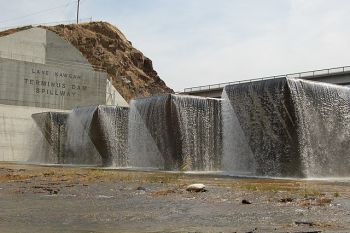Fusegate Spillways: Difference between revisions
Rmanwaring (talk | contribs) No edit summary |
No edit summary |
||
| Line 2: | Line 2: | ||
[[Category:Controlled Spillways]] | [[Category:Controlled Spillways]] | ||
---- | ---- | ||
{{Picture | |||
<!-- Add image file name (ex.image.jpg) --> | |||
|image= FusegateWEir.jpg | |||
<!--Add link if applicable --> | |||
|link= | |||
<!-- Add picture caption --> | |||
|caption= Terminus fusegate spillway. | |||
(Image Source: [https://creativecommons.org/licenses/by/3.0/deed.en Creative Commons) | |||
}} | |||
“These types of control structures are associated with staged releases and suited for auxiliary and emergency [[spillways]]. Fusegate spillways are a proprietary system (Patented product of Hydroplus), and its inclusion in this design standard should not be viewed as an endorsement by Reclamation. This spillway type provides a means of passing more frequent smaller flood events by overtopping the fusegates (via labyrinth or straight weir) and more remote larger flood events by tipping and displacing sections of the fusegate spillway. This type of control structure provides the ability to increase (maximize) reservoir storage and/or discharge capacity. An important consideration is the potentially large discharge capacity associated with [[operation]] from a small increase in reservoir water surface (particularly during remote large flood events that result in tipping and displacing sections of the fusegate spillway). The amount of flow that could be released from an operating fusegate must be carefully evaluated in terms of downstream impacts. Another consideration includes evaluating and mitigating erosion potential downstream of the fusegate that could lead to headcutting and undermining the fusegate control structure. Also note that once a fusegate spillway operates, the reservoir cannot be maintained above the control structure crest (base of the control structure containing the fusegates). This could result in the loss of reservoir storage until the fusegates have been reinstalled or replaced. Finally, this type of spillway is applicable to concrete, embankment, and [[Composite Dams|composite dams]]. Examples of fusegate spillways include [[Auxiliary Spillways|auxiliary spillways]] at the U.S. Army Corps of Engineers’ Terminus Dam (embankment) and Canton Dam (embankment).”<ref name="DS14">[[Design Standards No. 14: Appurtenant Structures for Dams (Ch. 3: General Spillway Design Considerations) | Design Standards No. 14: Appurtenant Structures for Dams (Ch. 3: General Spillway Design Considerations), USBR, 2022]]</ref> | “These types of control structures are associated with staged releases and suited for auxiliary and emergency [[spillways]]. Fusegate spillways are a proprietary system (Patented product of Hydroplus), and its inclusion in this design standard should not be viewed as an endorsement by Reclamation. This spillway type provides a means of passing more frequent smaller flood events by overtopping the fusegates (via labyrinth or straight weir) and more remote larger flood events by tipping and displacing sections of the fusegate spillway. This type of control structure provides the ability to increase (maximize) reservoir storage and/or discharge capacity. An important consideration is the potentially large discharge capacity associated with [[operation]] from a small increase in reservoir water surface (particularly during remote large flood events that result in tipping and displacing sections of the fusegate spillway). The amount of flow that could be released from an operating fusegate must be carefully evaluated in terms of downstream impacts. Another consideration includes evaluating and mitigating erosion potential downstream of the fusegate that could lead to headcutting and undermining the fusegate control structure. Also note that once a fusegate spillway operates, the reservoir cannot be maintained above the control structure crest (base of the control structure containing the fusegates). This could result in the loss of reservoir storage until the fusegates have been reinstalled or replaced. Finally, this type of spillway is applicable to concrete, embankment, and [[Composite Dams|composite dams]]. Examples of fusegate spillways include [[Auxiliary Spillways|auxiliary spillways]] at the U.S. Army Corps of Engineers’ Terminus Dam (embankment) and Canton Dam (embankment).”<ref name="DS14">[[Design Standards No. 14: Appurtenant Structures for Dams (Ch. 3: General Spillway Design Considerations) | Design Standards No. 14: Appurtenant Structures for Dams (Ch. 3: General Spillway Design Considerations), USBR, 2022]]</ref> | ||
Latest revision as of 15:28, 25 July 2023

|
| Terminus fusegate spillway.
(Image Source: [https://creativecommons.org/licenses/by/3.0/deed.en Creative Commons) |
“These types of control structures are associated with staged releases and suited for auxiliary and emergency spillways. Fusegate spillways are a proprietary system (Patented product of Hydroplus), and its inclusion in this design standard should not be viewed as an endorsement by Reclamation. This spillway type provides a means of passing more frequent smaller flood events by overtopping the fusegates (via labyrinth or straight weir) and more remote larger flood events by tipping and displacing sections of the fusegate spillway. This type of control structure provides the ability to increase (maximize) reservoir storage and/or discharge capacity. An important consideration is the potentially large discharge capacity associated with operation from a small increase in reservoir water surface (particularly during remote large flood events that result in tipping and displacing sections of the fusegate spillway). The amount of flow that could be released from an operating fusegate must be carefully evaluated in terms of downstream impacts. Another consideration includes evaluating and mitigating erosion potential downstream of the fusegate that could lead to headcutting and undermining the fusegate control structure. Also note that once a fusegate spillway operates, the reservoir cannot be maintained above the control structure crest (base of the control structure containing the fusegates). This could result in the loss of reservoir storage until the fusegates have been reinstalled or replaced. Finally, this type of spillway is applicable to concrete, embankment, and composite dams. Examples of fusegate spillways include auxiliary spillways at the U.S. Army Corps of Engineers’ Terminus Dam (embankment) and Canton Dam (embankment).”[1]
Citations:
Revision ID: 7467
Revision Date: 07/25/2023
